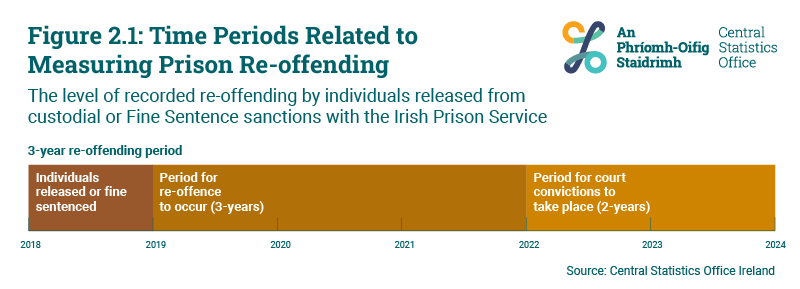Following the publication of the fifth Review of the Quality of Crime Statistics in October 2023, the Central Statistics Office (CSO) has lifted the 'Under Reservation' categorisation around Recorded Crime Statistics. This is possible because An Garda Síochána have introduced a range of quality measures over the last number of years which have resulted in sustained improvement in the quality of the underlying crime data. These changes give a level of assurance to users that they can rely on Recorded Crime Statistics.
For further information see our Lifting of Under Reservation categorisation for Recorded Crime Statistics FAQ page.
Following a review of the Prison Re-offending Statistics an error was identified with the age group labels presented in the release. '51 years and over' was incorrectly labelled as '50 years and over'. This labelling error did not affect the data.
As of 11 September 2025 all labels and text have been corrected. More details on these updates are available in an Information Note. We apologise for any inconvenience this may have caused.
This chapter outlines some more details about individuals who re-offended within three years of release from custody, and who secured a court conviction within a further two years.
Figure 2.1 below shows the time periods and process of establishing these re-offending indicators for the prison re-offending of persons released in 2018 (three-year re-offending). The three-year re-offending period refers to individuals released or fine sentenced in 2018. The time period for a re-offence to occur is three-years (2018 to 2021) and a further two-years are left for court decisions (convictions/acquittals) to take place.

More than four-fifths (84%) of individuals aged less than 21 who were released from custody in 2018 re-offended within three years of release. In addition, more than three-quarters (76%) of individuals between the age of 21 and 25 also re-offended over the same period of time following their release. In total these two age groups represented less than a quarter (647 out of 2,784) of the overall number of individuals released from custodial sentences in 2018. See Figure 2.2 and Table 2.1.
Individuals released from custody for Public Order offences consistently rank highly in re-offending estimates when compared to other offence groups. In 2018 more than three quarters (77%) of individuals who were released from sentences in relation to this offence category was convicted of a re-offence within three years. The lowest level of re-offending continues to be seen in relation to individuals released from sentences related to Sexual Offences (21%) or Homicide & Related offences (23%). The largest number of individuals released in 2018 were released from sentences related to Theft (610 of 2,784 in total). From this category seven in ten (70%) re-offended within three years of release. See Figure 2.3 and Table 2.2.
Note: The offence types that individuals are released from custody does not always correspond to the same re-offence type for the individual. Table 2.3 of this publication provides details of 3-year re-offence types.
More than a fifth (372 out of 1,729) of all individuals who re-offended within three years of release in 2018 re-offended in Theft related offences and more than one third (139 out of 372) of these re-offenders were also released from custody that related to the same offence group. In contrast, just 16 out of the 227 (7%) individuals released from custody in relation to offences linked with Attempts/Threats to Murder, Assault, Harassments & Related offences re-offended in the same offence type. See Table 2.3.
The proportion of females (65%) that re-offended within three years of release from custody in 2018 was slightly higher than males (62%). However, just 259 out of the total 2,525 individuals that were released in 2018 (10%) were female. See Figure 2.4 and Table 2.4.
Table 2.4 was updated on 11 March 2025. The figures for both Male and Female percentages for Non re-offenders were updated due to an error.
Learn about our data and confidentiality safeguards, and the steps we take to produce statistics that can be trusted by all.